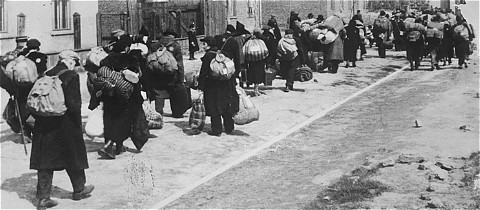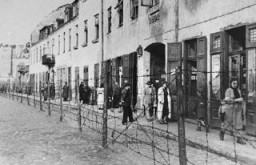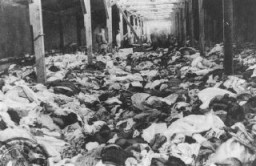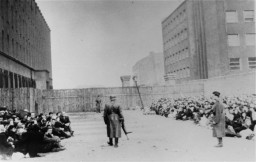
Life in the Ghettos
Life in the Ghettos Life in the ghettos was usually unbearable. Overcrowding was common. One apartment might have several families living in it. Plumbing broke down, and human waste was thrown in the streets along with the garbage. Contagious diseases spread rapidly in such cramped, unsanitary housing. People were always hungry. Germans deliberately tried to starve residents by allowing them to purchase only a small amount of bread, potatoes, and fat. Some residents had some money or valuables they could trade for food smuggled into the ghetto; others were forced to beg or steal to survive. During the long winters, heating fuel was scarce, and many people lacked adequate clothing. People weakened by hunger and exposure to the cold became easy victims of disease; tens of thousands died in the ghettos from illness, starvation, or cold. Some individuals killed themselves to escape their hopeless lives.
Every day children became orphaned, and many had to take care of even younger children. Orphans often lived on the streets, begging for bits of bread from others who had little or nothing to share. Many froze to death in the winter.
In order to survive, children had to be resourceful and make themselves useful. Small children in the Warsaw ghetto sometimes helped smuggle food to their families and friends by crawling through narrow openings in the ghetto wall. They did so at great risk, as smugglers who were caught were severely punished.
Many young people tried to continue their education by attending school classes organized by adults in many ghettos. Since such classes were usually held secretly, in defiance of the Nazis, pupils learned to hide books under their clothes when necessary, to avoid being caught.
Although suffering and death were all around them, children did not stop playing with toys. Some had beloved dolls or trucks they brought into the ghetto with them. Children also made toys, using whatever bits of cloth and wood they could find. In the Lodz ghetto, children turned the tops of empty cigarette boxes into playing cards.
Key Dates
February 8, 1940
Lodz Jews ordered into ghetto
The Germans order the establishment of a ghetto in the northeastern section of Lodz. Over 160,000 Jews, more than a third of the entire population of Lodz, are forced into a small area of the city. The Jews of Lodz formed, after Warsaw, the second largest Jewish community in prewar Poland. The Lodz ghetto is separated from the rest of the city by barbed-wire fencing. The ghetto area is divided into three parts by the intersection of two major roads, which are excluded from the ghetto. Footbridges are constructed to connect the three segments of the ghetto. Streetcars for the non-Jewish population of Lodz traverse the ghetto but are not permitted to stop within it. Living conditions in the ghetto are horrible. Most of the area does not have running water or a sewer system. Hard labor, overcrowding, and starvation are the dominant features of life.
January 16, 1942
Lodz Jews deported to Chelmno killing center
Deportations from the Lodz ghetto to the Chelmno killing center begin. German police will carry out roundups in the ghetto. Hundreds of Jews, mainly children, the elderly, and the sick, are killed on the spot during the deportations. By the end of September 1942, approximately 70,000 Jews and about 4,300 Roma (Gypsies) will have been deported to Chelmno, where they are killed in mobile gas vans (trucks with hermetically sealed compartments that serve as gas chambers).
June 23, 1944
Germans resume deportations from Lodz ghetto
Between September 1942 and May 1944, there are no major deportations from Lodz. The ghetto resembles a forced-labor camp. In the spring of 1944, the Nazis decide to destroy the Lodz ghetto. By then, Lodz is the last remaining ghetto in Poland, with a population of about 75,000 Jews. On June 23, 1944, the Germans resume deportations from Lodz. About 7,000 Jews are deported to Chelmno and killed. The deportations continue in July and August; most of the remaining ghetto population is deported to the Auschwitz-Birkenau extermination camp. The Lodz ghetto is eliminated.







